英美司法制度criminal law
英美法系刑事诉讼制度的历史沿革

英美法系刑事诉讼制度的历史沿革摘要:英美法系是指以英国普通法为主要基础建立起来的世界性法律体系,其中英国和美国的法律制度最具代表性。
本文将以英国和美国为契机探讨英美法系刑事诉讼制度的历史沿革,以期对这一制度的历史发展有一个大概的了解。
关键词:英美法系刑事诉讼制度历史沿革英国是一个具有悠久的法律传统的国家,其法律制度基本是在本土习惯基础上发展而来的,只是在很少的一些方面受到以罗马法为基础的欧洲大陆法律传统的影响,而美国法是在英国法的基础上经过本土化的改造而形成与发展起来的。
英国法和美国法所构成的英美法系对于世界上其他国家的法律的形成与发展产生了重要的影响,了解英美法系各种制度的发展历史对于研究其他各国的法律发展具有重要的意义。
通过学习我们可以了解到英美法系刑事诉讼制度的发展经历了一个漫长的过程,在这一悠久的历史进程中,刑事诉讼制度得到不断地发展与完善,最终形成了如今英美法系国家相对完善的刑事诉讼制度。
一,封建社会前期的刑事诉讼制度自5世纪中叶起,在日耳曼人大迁徙的过程中,日耳曼人的支系盎格鲁人,撒克逊人和裘特人侵入不列颠,建立了十几个小的独立国家。
7世纪初,诸小王国合并为7个王国,其中有六个为盎格鲁—撒克逊人所建。
827年,盎格鲁—撒克逊诸王国由西撒克斯国王爱格伯特统一成为一个国家,即英吉利王国,这就是英国史上的盎格鲁—撒克逊时期。
这一时期的法律制度是日耳曼法的组成部分,在本质上与法兰克等王国的法律制度没有什么重大区别,也确立了神明裁判的制度和公开审判的原则,同时,属于日耳曼法的《萨克森法典》的“法院从黎明到日落进行审判,日落后法院不能再行使权力”的规定也对其产生了重要的影响。
同时,这一时期的英国法也受到罗马法的影响。
罗马法最著名的《十二铜表法》和《查士丁尼法典》确立了一系列的诉讼制度。
在这一时期,帕皮尼安,保罗和乌尔比安主持的法庭发现并确立了一系列的法律原则,制度和规则,如:“已决事件被视为真理”的既判力原则,“举证责任在于确认之人而不再否认之人”的举证原则,“兼听”的调查原则,“任何人都没有使自己牵连进刑事案件的义务”的反对自证其罪原则,“任何人不得在自己的案件中担任法官”的法官中立原则,“任何人不应受两次磨难”的禁止重复追究原则,“一切行为都被推定是正确的和严肃的做出的”的理智推定原则等。
英美司法制度

三、英国的法院系统
英国法院组织存在着三个系统,英格兰和 威尔士为一个系统,苏格兰和北爱尔兰各为 一个系统,所谓英国的法院组织,是就英格 兰和威尔士这个系统而言的。
英国的法院组织分为民事法院系统和刑事 法院系统两大类。民事法院系统由郡法院、 高等法院、上诉法院和上议院四级构成,审 理有关债务纠纷、契约纠纷、家庭纠纷以及 遗嘱、离婚等民事案件;刑事法院系统由治 安法院、皇家刑事法院、上诉法院和上议院 构成,审理有关犯罪的案件。
不应列入司法权之内:监狱管理、警察机关 的刑事侦查、公证的行政管理、律师的行 政管理
司法权的特点
1、独立性 独立性是指法官行使审判权只服从法律,不受其 他机关、党派和个人的指挥。对法官的判决,只 有上级法院通过诉讼程序予以变更,其他机关和 个人不得变更。
2、被动性 被动性是指法院被动地行使职权,实行“不告不 理”的原则。只有当事人或检察机关起诉到法院, 法院才能决定是否进行审判,法院不能主动地去 解决纠纷或追究犯罪行为。
图示
上诉法院(民事)
上议院
上诉法院(刑事)
高等法院
衡平法院 家事法院 大法官法院
皇家刑事法院 治安法院
郡法院
行政法庭(裁判所)
英国司法制度的特征
法律至上 判例法制度 议会至上,司法独立 强调程序 对抗制的诉讼程序 司法系统复杂
五、美国的法院系统
美国的法院组织有联邦法院和州法院之分,它们
1921年颁布《裁判所和调查法庭法》设立了行政法庭, 审理大部分行政案件,它的上诉法院为高等法院。英国 目前有2000多个行政法庭,按其所管辖的案件的性质可 分为:社会和福利法庭、税收法庭、土地法庭、赔偿法 庭等。
两大法系司法制度比较(带动画哦)

一、英美法系的违宪审查制度
(二) 司法机关审查制
即由普通法院通过司法程序来审查和裁决立法、 即由普通法院通过司法程序来审查和裁决立法、 行政是否违宪。 行政是否违宪。 1.首创于美国 1.首创于美国——“马伯里诉麦迪逊” 首创于美国——“马伯里诉麦迪逊” 2.适用国家 2.适用国家——美国、加拿大、印度、巴基斯坦 适用国家——美国 加拿大、印度、 美国、 等64个国家 64个国家
一、大陆法系的违宪审查制度
(一)专门机关审查制
2.德国 2.德国——联邦宪法法院,主要职权: 德国——联邦宪法法院 主要职权: 联邦宪法法院, (1)法律违宪司法审查权 (2)权限裁决权 (3)弹劾审判权 (4)联邦选举裁决权 (5)裁决政党或其部门是否违宪的权力
一、大陆法系的违宪审查制度
3. 法国——宪法委员会 法国——宪法委员会 (1)法国1958年宪法规定:宪法委员会审查各项组 1958年宪法规定 法国1958年宪法规定: 织法、议会内部规章和普通法律是否违宪。 织法、议会内部规章和普通法律是否违宪。 (2)审查程序基于申请方可启动 (3)有权申请的主体:总统、总理、国会两院议长、 有权申请的主体:总统、总理、国会两院议长、 60名国民议会议员或60名参议院议员。 60名国民议会议员或60名参议院议员。 名国民议会议员或60名参议院议员 (4)宪法委员会对违宪审查的裁决是终审的
(一)例外——日本 例外——日本
被认为属于大陆法系的日本,在二战后受 被认为属于大陆法系的日本, 到美国司法体制的巨大影响, 到美国司法体制的巨大影响,采用了以司法机 关为主体的违宪审查制度。 关为主体的违宪审查制度。 不同之处:日本的违宪审查制来源于宪法 不同之处: 的明文规定。 的明文规定。
谢 谢 观 赏
英美法系判例制度 英语
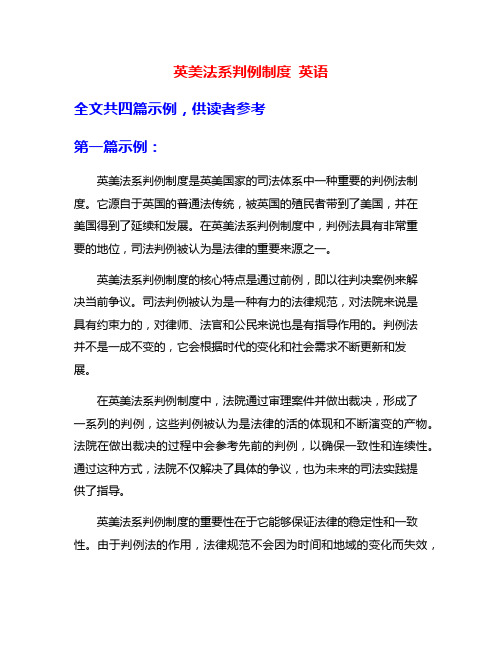
英美法系判例制度英语全文共四篇示例,供读者参考第一篇示例:英美法系判例制度是英美国家的司法体系中一种重要的判例法制度。
它源自于英国的普通法传统,被英国的殖民者带到了美国,并在美国得到了延续和发展。
在英美法系判例制度中,判例法具有非常重要的地位,司法判例被认为是法律的重要来源之一。
英美法系判例制度的核心特点是通过前例,即以往判决案例来解决当前争议。
司法判例被认为是一种有力的法律规范,对法院来说是具有约束力的,对律师、法官和公民来说也是有指导作用的。
判例法并不是一成不变的,它会根据时代的变化和社会需求不断更新和发展。
在英美法系判例制度中,法院通过审理案件并做出裁决,形成了一系列的判例,这些判例被认为是法律的活的体现和不断演变的产物。
法院在做出裁决的过程中会参考先前的判例,以确保一致性和连续性。
通过这种方式,法院不仅解决了具体的争议,也为未来的司法实践提供了指导。
英美法系判例制度的重要性在于它能够保证法律的稳定性和一致性。
由于判例法的作用,法律规范不会因为时间和地域的变化而失效,司法实践也能够在一个相对稳定的框架内进行。
判例法还能够帮助法律专业人士更好地预测法院的裁决结果,提高司法效率和公正性。
英美法系判例制度也存在一些问题。
因为对判例的依赖过重,可能会使法律发展受到限制,难以适应社会的快速变化。
判例法可能会导致司法决策的保守化,法官可能更倾向于坚守传统判例而不愿开创新的法律问题解决方式。
判例法也可能存在一定的不确定性,因为不同的法院可能对相同的案件做出不同的裁决,导致法律实践的不一致性。
英美法系判例制度在保障法律稳定性和一致性方面发挥着重要作用,但同时也面临着一些挑战和问题。
在不断的实践和总结中,英美法系判例制度将不断发展和完善,以更好地适应社会的需求和司法实践的要求。
第二篇示例:英美法系判例制度是世界上最为著名和广泛应用的法律体系之一,它源自英国法律体系,并在美国及其其他前英国殖民地广泛应用。
这种法律体系的核心特点是通过判例法形成和发展法律原则,而不是通过法典或宪法来规范社会行为。
101125,英美司法制度

101125,英美司法制度101125英美司法制度英美法系概况一、英美法的历史沿革(一)、英国法的形成与发展1、英国封建法律体系的形成英国法的源头是盎格鲁·撒克逊时代的习惯法。
随着王权的强大和完善的皇家司法机构的建立,逐渐形成了普通法、衡平法和制定法三大法律渊源,从而确立了英国封建法律体系。
(1)、普通法的形成普通法指的是12世纪前后发展起来的、由普通法院创制的通行于全国的普遍适用的法律。
它的形成是中央集权和司法统一的直接后果。
1066年诺曼公爵威廉征服英国后,他和继任者为巩固统治,扩大王权,采取进行土地调查、编制“末日审判书”(始于1086年,又称“最终税册”/domesdayBook)等多种措施,加强中央集权。
在统一司法方面,国王建立了御前会议,并从前者中逐渐分立出具有司法职能的财政法院、王座法院和普通诉讼法院。
这些法院最初只在伦敦皇家威斯敏斯特教堂(westminsterabbey)审理案件,但为了扩大王室管辖权,法官们开始到各地巡回审判。
亨利二世统治时期的司法改革对普通法的形成起了很大的推动作用。
通过颁布《温莎诏令》、《克拉灵顿诏令》等一系列命令,确立于陪审制,并将巡回审判制度化。
法官们进行巡回审判时,在陪审团的帮助下,依据王室法令参照当地习惯来审理案件。
回到伦敦的皇家威斯敏斯特教堂后,他们互相交流参照各地习惯形成的判案意见,承认彼此的判决,并约定在以后巡回审判时使用。
在此基础上,逐渐形成了通行全国的普通法,所以后人习称其为判例法。
体现王权的令状制也与普通法的发展有密切关系。
它要求原告只在申请到特定的以国王名义签发的令状后,才能向法院主张实体权利的保护。
令状成为诉权凭证,无令状就不能起诉。
“程序先于权利”的普通法特点与此不无关系。
(2)、衡平法的兴起由于普通法在传统令状制度下,存在着保护范围有限、内容僵化、救济方法较少的缺陷,随着社会经济的发展,已不能满足人们的需要。
得不到背通法院公正保护的当事人,依照历史传统直接向国王提出的申诉越来越多,国王遂将其委托给大法官进行审理。
[法律资料]美国刑事诉讼法_OK
![[法律资料]美国刑事诉讼法_OK](https://img.taocdn.com/s3/m/45e38de8227916888586d729.png)
法违宪的案件则由3名法官组成合议庭审理;特别
重大案件由全体法官审理称为全庭审理(en
bench)。
2021/8/18
23
(2)联邦上诉法院 始创于1891年; 现50个州设11个巡回上诉法院,华盛顿特区单设1
所联邦巡回区上诉法院,共计12所; 只审理上诉案件,没有初审权; 一般由3名巡回法官组成合议庭审理,重大案件也
2021/8/18
14
4.美国乡间小镇警察局通常只有一、两名警察;
5.警察属于当地政府雇员,装备薪水均由地方财政
开支,因此警察局规模的大小、人员的多少,完 全取决于当地政府的财政能力和维护治安的实际 需要;
6.大学校园、桥梁隧道等重要设施也都有自己的警 察;
7.各州、县、市、镇警察(警徽标志、着装样式等 各不相同)在其管辖范围内独立行使职权;
2021/8/18
26
(二)州法院
凡宪法未规定属于联邦法院管辖而又未禁止各州管辖的案
件,皆由州法院管辖。所以州的司法权较广泛,由州法院
审理的案件约占全国案件的90%。州法院分普通法院和专 门法院,专门法院通常是初审法院,如未成年人法院、家
诉讼模式与“法官造法”仍然是美国刑事司法的
主要特征。
2021/8/18
6
第一节 美国刑事司法制度的形成和特点
三、美国刑事诉讼的宪法保障
美国刑事司法制度的最大特点,就是将一些直接涉及公民
人权和自由的诉讼行为上升到宪法高度,为公民在刑事诉讼
中的权利提供宪法性的保障。
1.获得律师帮助的权利
(1)美国宪法第六修正案规定该权利;
(1)源自第六修正案;
(2)内容包括两个方面:要求证人出庭作证的权利;
提出辩护的权利,包括被告人传唤己方证人和提 出自己关于案件事实的说法的权利。
英美法律体系_案例法(3篇)
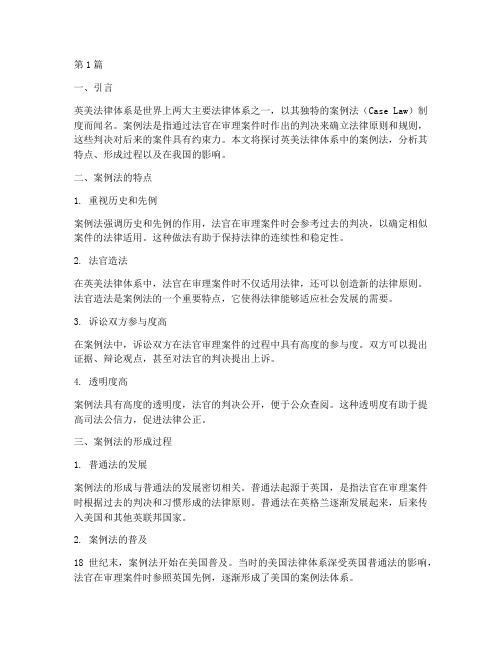
第1篇一、引言英美法律体系是世界上两大主要法律体系之一,以其独特的案例法(Case Law)制度而闻名。
案例法是指通过法官在审理案件时作出的判决来确立法律原则和规则,这些判决对后来的案件具有约束力。
本文将探讨英美法律体系中的案例法,分析其特点、形成过程以及在我国的影响。
二、案例法的特点1. 重视历史和先例案例法强调历史和先例的作用,法官在审理案件时会参考过去的判决,以确定相似案件的法律适用。
这种做法有助于保持法律的连续性和稳定性。
2. 法官造法在英美法律体系中,法官在审理案件时不仅适用法律,还可以创造新的法律原则。
法官造法是案例法的一个重要特点,它使得法律能够适应社会发展的需要。
3. 诉讼双方参与度高在案例法中,诉讼双方在法官审理案件的过程中具有高度的参与度。
双方可以提出证据、辩论观点,甚至对法官的判决提出上诉。
4. 透明度高案例法具有高度的透明度,法官的判决公开,便于公众查阅。
这种透明度有助于提高司法公信力,促进法律公正。
三、案例法的形成过程1. 普通法的发展案例法的形成与普通法的发展密切相关。
普通法起源于英国,是指法官在审理案件时根据过去的判决和习惯形成的法律原则。
普通法在英格兰逐渐发展起来,后来传入美国和其他英联邦国家。
2. 案例法的普及18世纪末,案例法开始在美国普及。
当时的美国法律体系深受英国普通法的影响,法官在审理案件时参照英国先例,逐渐形成了美国的案例法体系。
3. 案例法的完善随着时间的推移,案例法体系不断完善。
法官在审理案件时更加注重法律原则的适用,同时,立法机构也加强对案例法的监督和指导。
四、案例法在我国的影响1. 参考价值案例法在我国具有参考价值。
法官在审理案件时可以参考国外的案例,借鉴其经验,提高审判水平。
2. 立法借鉴案例法为我国立法提供了借鉴。
立法机构可以参考国外的案例,完善我国的法律体系。
3. 司法改革案例法对我国司法改革具有一定的启示。
借鉴案例法,我国可以推进司法公开、加强法官队伍建设,提高司法公信力。
英国与美国的司法制度

英国与美国的司法制度篇一:美国的司法制度/什么是美国诉讼审判制度的特点?一言以概之:陪审团审判!什么是陪审团审判制度的特点?一言以概之:外行领导内行!陪审团审判是英美法系最具特色的制度之一。
它像英国普通法一样历史久远,其起源可以上溯到古代罗马法。
在当代美国司法体制中,陪审团主要分为两种。
第一种是大陪审团,又称“起诉陪审团”,其角色大致相当于“人民检察院”。
它通常由案发所在地区的23位普通公民组成,其职能并非裁定被告是否有罪,而是在法院正式立案之前,传唤与案件有关的人证和物证,决定对有争议性的重大案件是否应当立案起诉。
一旦作出裁定,大陪审团就自动解散,由检察官接手办案。
在“拉链门”案中,把克林顿折腾得灰头土脸、狼狈不堪,并裁决立案起诉的陪审团,就是这种大陪审团。
另一种是小陪审团,又称“审判陪审团”,其角色大致相当于“人民法院”。
它通常由案发所在地区的12位普通公民组成,负责对刑事和民事案件中的被告人是否构成刑事犯罪或民事侵权作出裁决。
如果裁决无罪或不构成侵权,审判即告结束。
如果裁定有罪或侵权成立,则由主持审判的法官依法量刑,作出正式司法判决。
在球星辛普森涉嫌杀人案中,以检方呈庭证据漏洞百出为由,将这位橄榄球巨星无罪开释的陪审团,就是这种小陪审团。
陪审团制度在当代法治社会中的作用和价值,是一个颇具争议性的问题。
反对者认为,由一帮外行组成的陪审团,竟然高居于职业法官之上,对重大法律问题做出最终裁决,这简直就是世界上最愚蠢的一种司法审判制度。
提出此类批评的人,正是一个不懂陪审团如何运作的法律外行。
在美国司法制度中,陪审团认定事实问题,法官裁定法律问题,两者的分工和职能泾渭分明。
这种制度设计之目的,恰恰在于排除陪审员的法律专业化倾向,使司法过程中的事实问题与法律问题有所区分。
对于案件中的事实问题,比如在辛普森案中,出庭做证的警官是否撒了弥天大谎,检方呈庭的血迹和手套等证据是否能够令人信服地证明被告有罪,这类问题并未涉及复杂深奥、令人费解的法律和法理。
英美司法制度criminal law
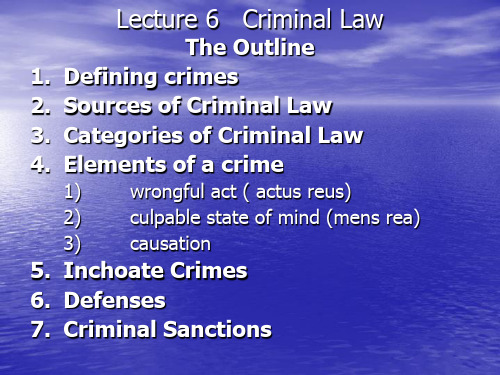
Elements of a Crime
A crime including the following components: (1)
the wrongful act (actus reus); (2) the culpable state of mind (mens rea)); (3) causation.
➢ It is often difficult to prove that person acted
with a guilty mind, and prosecutors often have to prove it indirectly and circumstantially.
➢ The Model PenThe wrongful act: an unlawful voluntary
act– a voluntary act occurs when the accused causes his or her body to move in a manner that produces prohibited conduct.
sentence of imprisonment of over one year are felonies, while those authorizing sentences of one year or less are misdemeanors.
Classifying Crimes
In the U.S.
against the public that is punishable by imprisonment or fine (or both).
➢a wrong -- an act that violates the law as
2020司法考试《一卷》法制史考点:英美司法制度
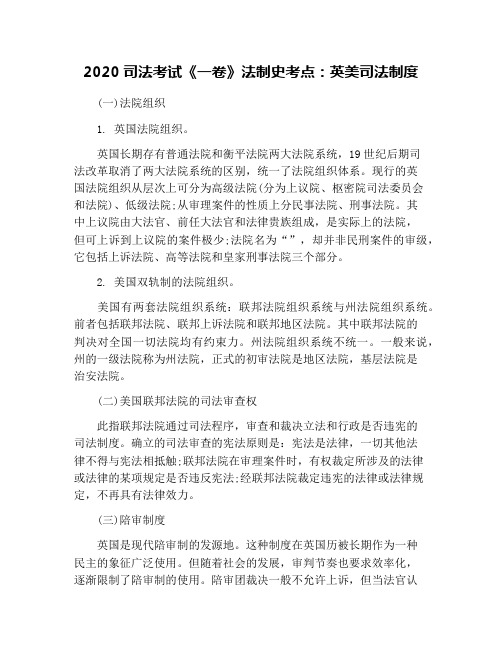
2020司法考试《一卷》法制史考点:英美司法制度(一)法院组织1. 英国法院组织。
英国长期存有普通法院和衡平法院两大法院系统,19世纪后期司法改革取消了两大法院系统的区别,统一了法院组织体系。
现行的英国法院组织从层次上可分为高级法院(分为上议院、枢密院司法委员会和法院)、低级法院;从审理案件的性质上分民事法院、刑事法院。
其中上议院由大法官、前任大法官和法律贵族组成,是实际上的法院,但可上诉到上议院的案件极少;法院名为“”,却并非民刑案件的审级,它包括上诉法院、高等法院和皇家刑事法院三个部分。
2. 美国双轨制的法院组织。
美国有两套法院组织系统:联邦法院组织系统与州法院组织系统。
前者包括联邦法院、联邦上诉法院和联邦地区法院。
其中联邦法院的判决对全国一切法院均有约束力。
州法院组织系统不统一。
一般来说,州的一级法院称为州法院,正式的初审法院是地区法院,基层法院是治安法院。
(二)美国联邦法院的司法审查权此指联邦法院通过司法程序,审查和裁决立法和行政是否违宪的司法制度。
确立的司法审查的宪法原则是:宪法是法律,一切其他法律不得与宪法相抵触;联邦法院在审理案件时,有权裁定所涉及的法律或法律的某项规定是否违反宪法;经联邦法院裁定违宪的法律或法律规定,不再具有法律效力。
(三)陪审制度英国是现代陪审制的发源地。
这种制度在英国历被长期作为一种民主的象征广泛使用。
但随着社会的发展,审判节奏也要求效率化,逐渐限制了陪审制的使用。
陪审团裁决一般不允许上诉,但当法官认为陪审团的裁决存有重大错误时,能够加以撤销,重新组织陪审团审判。
(四)辩护制度(1)一是对抗制,又称“辩论制”,即民事案件中的原被告以及刑事案件中的公诉人和被告律师在法庭上相互对抗,提出各自的证据,询问己方证人,盘问对方证人,并在此基础上相互辩论。
法官主持开庭,并对双方的动议和异议作出裁决,但不主动调查,只充当消极仲裁人的角色。
(2)二是英国的律师传统上分为两大类:出庭律师、事务律师。
英国美国政治制度英语作文

英国与美国的政治制度:一种比较的视角The political systems of Britain and the United States, both founded on the principles of democracy and representative government, exhibit significant similarities yet retain distinct characteristics that reflect their unique historical, cultural, and social backgrounds. This essay aims to compare and contrast the political systems of these two nations, highlighting their commonalities and differences.**一、议会制度**Both Britain and the United States operate under a parliamentary system, where the legislature is the supreme authority. In Britain, the Parliament consists of the House of Commons, the House of Lords, and the Monarch. The Houseof Commons, elected by the people, holds the power toinitiate and pass bills, while the House of Lords, composed of hereditary peers, life peers, and bishops, has the power to delay or reject bills. The Monarch, as the head of state, has limited powers and serves as a figurehead.In the United States, the Congress serves as the legislature and is composed of the House of Representatives and the Senate. The House of Representatives is directly elected by the people and has the power to initiate bills, while the Senate is elected indirectly and has the power to review and ratify treaties. The President, as the head of state and government, has executive powers and is elected separately from the Congress.**二、行政制度**The executive branch in Britain is headed by the Prime Minister, who is typically the leader of the politicalparty with the majority in the House of Commons. The Prime Minister appoints ministers and forms the Cabinet, which is responsible for formulating and implementing government policies. The Monarch, as the head of state, appoints the Prime Minister and ministers but has no role in policy-making.In the United States, the President is the head of both the state and the executive branch. The President iselected directly by the people and appoints Cabinet members, who head various departments and agencies. The Presidenthas the power to veto bills passed by Congress, appoint judges and other federal officials, and conduct foreign policy.**三、司法制度**Both Britain and the United States have an independent judiciary that interprets and applies the law. In Britain, the Supreme Court is the highest court of appeal for civil cases, while the House of Lords acts as the highest courtfor criminal cases. The judiciary is appointed by the Monarch on the advice of the Prime Minister and Lords.In the United States, the Supreme Court is the highest court in the nation and has the power to interpret the Constitution and federal laws. The judges of the Supreme Court are appointed by the President and confirmed by the Senate. The judiciary is independent of the executive and legislative branches, ensuring the separation of powers.**四、Conclusion**While the political systems of Britain and the United States share common features such as a parliamentary system, an executive branch headed by a prime minister or president,and an independent judiciary, they also differsignificantly in terms of their structure, powers, and responsibilities. These differences reflect the unique historical, cultural, and social backgrounds of these two nations. Understanding these differences is crucial for comprehending the political landscape and governance models of Britain and the United States.。
英美司法制度异同
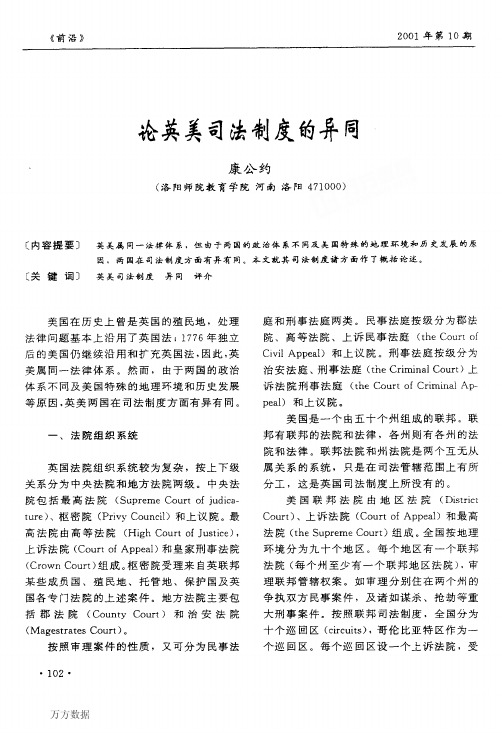
《前沿》2001年第10期(内容提要][关键词]论英美司法制度的异同康公约(洛阳师院教育学院河南洛阳471000)英美属同一法律体系,但由于两国的政治体系不同及美国特殊的地理环境和历史发展的原因,两国在司法制度方面有异有同。
本文就其司法制度诸方面作了概括论述。
英美司法制度异同评介美国在历史上曾是英国的殖民地,处理法律问题基本上沿用了英国法;1776年独立后的美国仍继续沿用和扩充英国法,因此,英美属同一法律体系。
然而,由于两国的政治体系不同及美国特殊的地理环境和历史发展等原因.英美两国在司法制度方面有异有同。
一、法院组织系统英国法院组织系统较为复杂,按上下级关系分为中央法院和地方法院两级。
中央法院包括最高法院(SupremeCourtofjudica—ture)、枢密院(PrivyCouncil)和上议院。
最高法院由高等法院(HighCourtofJustice),上诉法院(CourtofAppeal)和皇家刑事法院(CrownCourt)组成。
枢密院受理来自英联邦某些成员国、殖民地、托管地、保护国及英国各专门法院的上述案件。
地方法院主要包括郡法院(CountyCourt)和治安法院(MagestratesCourt)。
按照审理案件的性质,又可分为民事法·102·庭和刑事法庭两类。
民事法庭按级分为郡法院、高等法院、上诉民事法庭(theCourtofCivilAppeal)和上议院。
刑事法庭按级分为治安法庭、刑事法庭(theCriminalCourt)上诉法院刑事法庭(theCourtofCriminalAp—peal)和上议院。
美国是一个由五十个州组成的联邦。
联邦有联邦的法院和法律.各州则有各州的法院和法律。
联邦法院和州法院是两个互无从属关系的系统,只是在司法管辖范围上有所分工,这是英国司法制度上所没有的。
美国联邦法院由地区法院(DistrictCourt)、上诉法院(CourtofAppeal)和最高法院(theSupremeCourt)组成。
2020司法考试法制史知识点:英美司法制度
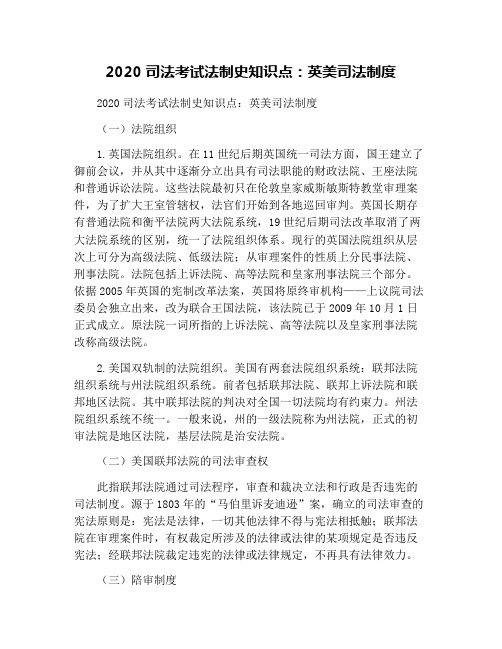
2020司法考试法制史知识点:英美司法制度2020司法考试法制史知识点:英美司法制度(一)法院组织1.英国法院组织。
在11世纪后期英国统一司法方面,国王建立了御前会议,并从其中逐渐分立出具有司法职能的财政法院、王座法院和普通诉讼法院。
这些法院最初只在伦敦皇家威斯敏斯特教堂审理案件,为了扩大王室管辖权,法官们开始到各地巡回审判。
英国长期存有普通法院和衡平法院两大法院系统,19世纪后期司法改革取消了两大法院系统的区别,统一了法院组织体系。
现行的英国法院组织从层次上可分为高级法院、低级法院;从审理案件的性质上分民事法院、刑事法院。
法院包括上诉法院、高等法院和皇家刑事法院三个部分。
依据2005年英国的宪制改革法案,英国将原终审机构——上议院司法委员会独立出来,改为联合王国法院,该法院已于2009年10月1日正式成立。
原法院一词所指的上诉法院、高等法院以及皇家刑事法院改称高级法院。
2.美国双轨制的法院组织。
美国有两套法院组织系统:联邦法院组织系统与州法院组织系统。
前者包括联邦法院、联邦上诉法院和联邦地区法院。
其中联邦法院的判决对全国一切法院均有约束力。
州法院组织系统不统一。
一般来说,州的一级法院称为州法院,正式的初审法院是地区法院,基层法院是治安法院。
(二)美国联邦法院的司法审查权此指联邦法院通过司法程序,审查和裁决立法和行政是否违宪的司法制度。
源于1803年的“马伯里诉麦迪逊”案,确立的司法审查的宪法原则是:宪法是法律,一切其他法律不得与宪法相抵触;联邦法院在审理案件时,有权裁定所涉及的法律或法律的某项规定是否违反宪法;经联邦法院裁定违宪的法律或法律规定,不再具有法律效力。
(三)陪审制度英国是现代陪审制的发源地。
这种制度在英国历被长期作为一种民主的象征广泛使用。
但随着社会的发展,审判节奏也要求效率化,逐渐限制了陪审制的使用。
陪审团的职责是就案件的事实部分实行裁决,法官则在陪审团裁决的基础上就法律问题实行判决。
美国刑事诉讼程序简介
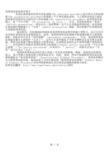
美国刑事诉讼程序简介
英美法系国家的抗辩式诉讼制度(the adversary procedure)是在控告式诉讼制度(the accusatorial procedure)的基础上产生和发展起来的。与之相对应的是大陆法系国家采用的纠问式或审问士诉讼制度(the inquisitorial procedure).前者的基本原则之一是“不告不理”(No accusation, no trial.)。不过,英国的传统是“私诉”(private prosecution),即由公民(包括警察)以个人名义提起刑事诉讼;而美国则在殖民地时期就建立了“公诉”(public prosecution)制度,即由检察官代表政府或人民提起刑事诉讼。
毫无疑问,对抗制或抗辩制也是美国刑事诉讼程序的最主要特点,而且它往往具有较民事诉讼更为重要的意义。此外,美国的刑事诉讼规则中很强调对被告人权利的保护,因此有许许多多“程序保障”(procedural safeguards)。不过,美国的刑事诉讼制度对被告人的保护“太多了,以至于在某些情况下不得不牺牲社会安全和公众利益。刑事司法系统不能有效地打击犯罪活动,这显然是美国社会中犯罪问题严重的原因之一。有些美国学者批评美国的刑事司法系统(criminal justice system)是“不公正的无系统”(“no-justice non-system”,在英语中,”justice”一次既可以表示“司法”也可以表示“公正”)。
法律英语翻译 /archives/2039
�
美国的刑事诉讼法律在很大程度上受其宪法的影响。例如,美国宪法的第四、第五、第六等修正案都直接与刑事诉讼有关。因此,美国一些法学院教授刑事诉讼法的课程就称为“宪法刑事诉讼”(Constitutional Criminal Procedure)。美国各州都有自己的刑事诉讼法典。最高法院于1946年颁布的“联邦刑事诉讼规则”(Federal Rules of Criminal Procedure)对各州的影响要比其民事诉讼规格的影响小得多。
美国刑事司法制度
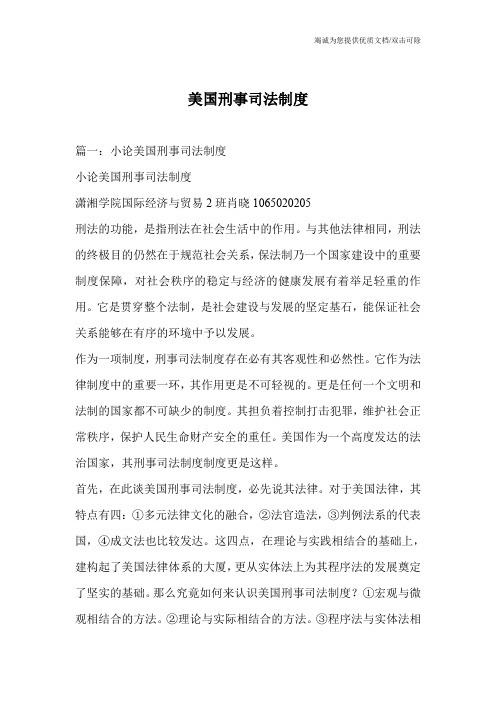
美国刑事司法制度篇一:小论美国刑事司法制度小论美国刑事司法制度潇湘学院国际经济与贸易2班肖晓1065020205刑法的功能,是指刑法在社会生活中的作用。
与其他法律相同,刑法的终极目的仍然在于规范社会关系,保法制乃一个国家建设中的重要制度保障,对社会秩序的稳定与经济的健康发展有着举足轻重的作用。
它是贯穿整个法制,是社会建设与发展的坚定基石,能保证社会关系能够在有序的环境中予以发展。
作为一项制度,刑事司法制度存在必有其客观性和必然性。
它作为法律制度中的重要一环,其作用更是不可轻视的。
更是任何一个文明和法制的国家都不可缺少的制度。
其担负着控制打击犯罪,维护社会正常秩序,保护人民生命财产安全的重任。
美国作为一个高度发达的法治国家,其刑事司法制度制度更是这样。
首先,在此谈美国刑事司法制度,必先说其法律。
对于美国法律,其特点有四:①多元法律文化的融合,②法官造法,③判例法系的代表国,④成文法也比较发达。
这四点,在理论与实践相结合的基础上,建构起了美国法律体系的大厦,更从实体法上为其程序法的发展奠定了坚实的基础。
那么究竟如何来认识美国刑事司法制度?①宏观与微观相结合的方法。
②理论与实际相结合的方法。
③程序法与实体法相结合的方法。
④原则性规定与具体条款规定相结合的方法。
⑤多角度,多层次的比较方法。
这样,才能全面、客观的熟知。
美国和我国的中央制度不同,其属于联邦制。
因为美国没有一个完全统一的刑事诉讼法,联邦有一个联邦的刑事诉讼法,每个州有自己的刑事诉讼法,还有一些地方的刑事诉讼法,所以美国有五十几个刑事诉讼法,但是都大同小异,都符合美国联邦宪法的基本要求。
这也其美国法制高度发达的保障。
所以,学习美国刑事司法制度,必须从联邦高度与地方层面来把握。
然而,在有效控制犯罪和有效保护人民人身自由权利两者间却不可能有完全的统一。
许多国家在这方面都或多或少存在些问题。
那么,美国刑事司法制度又是如何协调,其效果又如何?对于美国刑事司法制度,其内容是广泛的,贯穿于整个刑事司法过程中。
11 英美刑法
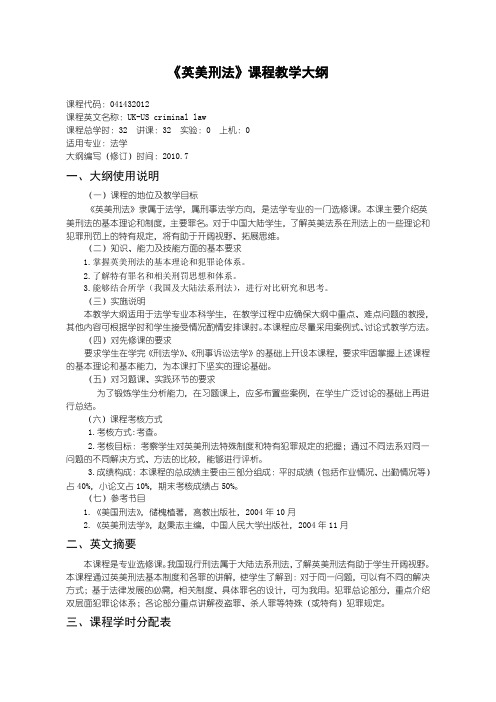
《英美刑法》课程教学大纲课程代码:041432012课程英文名称:UK-US criminal law课程总学时:32 讲课:32 实验:0 上机:0适用专业:法学大纲编写(修订)时间:2010.7一、大纲使用说明(一)课程的地位及教学目标《英美刑法》隶属于法学,属刑事法学方向,是法学专业的一门选修课。
本课主要介绍英美刑法的基本理论和制度,主要罪名。
对于中国大陆学生,了解英美法系在刑法上的一些理论和犯罪刑罚上的特有规定,将有助于开阔视野、拓展思维。
(二)知识、能力及技能方面的基本要求1.掌握英美刑法的基本理论和犯罪论体系。
2.了解特有罪名和相关刑罚思想和体系。
3.能够结合所学(我国及大陆法系刑法),进行对比研究和思考。
(三)实施说明本教学大纲适用于法学专业本科学生,在教学过程中应确保大纲中重点、难点问题的教授,其他内容可根据学时和学生接受情况酌情安排课时。
本课程应尽量采用案例式、讨论式教学方法。
(四)对先修课的要求要求学生在学完《刑法学》、《刑事诉讼法学》的基础上开设本课程,要求牢固掌握上述课程的基本理论和基本能力,为本课打下坚实的理论基础。
(五)对习题课、实践环节的要求为了锻炼学生分析能力,在习题课上,应多布置些案例,在学生广泛讨论的基础上再进行总结。
(六)课程考核方式1.考核方式:考查。
2.考核目标:考察学生对英美刑法特殊制度和特有犯罪规定的把握;通过不同法系对同一问题的不同解决方式、方法的比较,能够进行评析。
3.成绩构成:本课程的总成绩主要由三部分组成:平时成绩(包括作业情况、出勤情况等)占40%,小论文占10%,期末考核成绩占50%。
(七)参考书目1.《美国刑法》,储槐植著,高教出版社,2004年10月2.《英美刑法学》,赵秉志主编,中国人民大学出版社,2004年11月二、英文摘要本课程是专业选修课。
我国现行刑法属于大陆法系刑法,了解英美刑法有助于学生开阔视野。
本课程通过英美刑法基本制度和各罪的讲解,使学生了解到:对于同一问题,可以有不同的解决方式;基于法律发展的必需,相关制度、具体罪名的设计,可为我用。
英美法律制度(双语)第一章-案例阅读技巧

(2)相关词汇: A. PARTIESFra bibliotek
Plaintiff(s) v Defendant(s) (civil matters) Applicant(s) v Respondent(s) (civil matters) Appellant(s) v Respondent(s) (appeal cases) Prosecution v Accused (criminal matter before a judge or jury: indictable offences) Informant v Defendant(s) (criminal matter before a magistrate: summary offences) 初审案件判决中的原告与被告称为:plaintiff and defendant 中级上诉法院判决书中的上诉方称为:appellant,被上诉方称为:appellee 最高法院判决书中的上诉方称为:petitioner,被上诉方称为:respondent NOTE: in re (prep. Law: In the matter or case of; in regard to.) 案件名称前加上in re通常意味着只有一方当事人的案件,如破产、遗嘱、监护人、吊销律 师资格、移民申请、藐视法庭等案件。 Ex parte (From or on one side only, with the other side absent or unrepresented)(单方面的仅在一方面的或仅从一方面的,而另一方缺席或不到场: E.g.: testified ex parte 单方面证明;an ex parte hearing 单方面申诉.)案件名称前加上ex parte通常表示可单方面进行的庭审程序,无须通知诉讼的另一方或无须让其出庭答辩。 审前程序或庭审过程中,Pleading(诉讼文件)或者动议(Motion)名称冠有ex parte,表示 涉及单方面进行的法定程序。当事人事先无需通知诉讼的另一方或无需让对方出庭答辩。 Anglo-American Legal Systems Eg.诉讼保全动议
英美司法制度criminal procedure
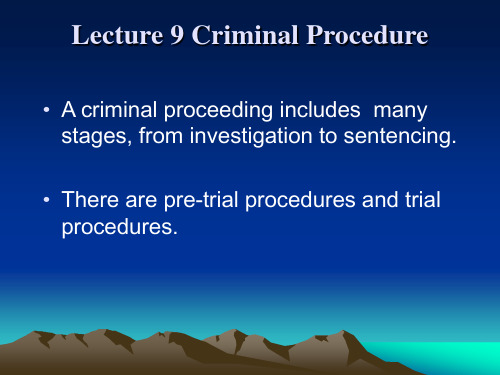
Lecture 9 Criminal Procedure
• Miranda Warning
Before any pertinent questioning of a suspect is done, the police have been required to recite the Miranda warning. Otherwise, the statements made by the suspect could not be used as evidence.
Lecture 9 Criminal Procedure
C. Preliminary hearing
At the preliminary hearing it is determined by a judge whether there are reasonable grounds for believing that a crime has been committed and that the accused was the perpetrator. If both questions are answered in the affirmative, the accused will be bound over for trial.
Lecture 9 Criminal Procedure
• D. Formal accusation (1). Indictment * Federal Government and over half of the states have indictment by grand jury; * Jury passes a true bill or a no bill (ignoramus) (2). Indictment by information
英美法系检察制度的起源

英美法系检察制度的起源英美法系检察制度的起源英美法系检察制度同英美法系的法学发展一样发端于英国。
英国检察制度的发展离不开英国法制发展历史。
公元5世纪日耳曼人入侵罗马帝国前后,不列颠岛遭受了来自现今德国境内的盎格鲁撒克逊人的入侵。
在盎格鲁撒克逊人入侵前,不列颠岛属于罗马帝国的势力范围,法律制度深受罗马帝国的影响。
罗马国家是一个打破血缘而表现为理性化契约关系的商品经济发达的国家,个人自由、平等、权利等法律观念对于强调人的个性和权利具有十分重要的作用,这些对于英国法制的发展产生了极为重要的影响。
从盎格鲁撒克逊人进入不列颠到11世纪诺曼人威廉公爵登陆大不列颠之前这一段时期,英国适用的早期基本上是盎格鲁撒克逊人的习惯法。
在诉讼制度方面,主要采用私人追诉形式的弹劾式诉讼。
1066年诺曼底公爵统治英国后,建立起了强大的王权,进行司法改革,统一全国司法机关,完善了包括检察制度在内的司法制度,形成了在区别于欧洲大陆国家的在判例的基础上形成了具有浓厚习惯法特色的普通法系统。
从诉讼形式上看,英国普通法的传统是私诉,私诉曾长期是英国诉讼制度中的基本起诉形式。
在这种诉讼形式中,所有犯罪行为都被认为是个人之间的事情,是一个人对另外一个人权益的侵犯,而不被认为是对国家权益的侵害,国家不应当主动去干预他们之间的行为,与这种习惯法并存的诉讼形式便是“诉讼责任个人化”的弹劾式诉讼。
从法国早期的代理人制度逐步深化为检察官的过程中可以看出,代表权力的检察权永远也不会在弹劾式诉讼制度下产生。
封建庄园和代理人制度在早期英国也同样存在,13世纪时英王就开始派遣律师代替他起诉、支持控诉、维护王室权力、调查杀人案件、进行听审等。
但英王的代理人或者说是律师却一直是他的私人代表,国家公权的身份长期不与他们沾边。
直到现在,英国的总检察署仍被称为中央法律事务部,英国的公诉官和律师之间可以划等号。
弹劾式诉讼的长期影响是导致英国疏于国家追诉,一直不关心具有国家公诉职能的检察机关的建立的主要因素。
- 1、下载文档前请自行甄别文档内容的完整性,平台不提供额外的编辑、内容补充、找答案等附加服务。
- 2、"仅部分预览"的文档,不可在线预览部分如存在完整性等问题,可反馈申请退款(可完整预览的文档不适用该条件!)。
- 3、如文档侵犯您的权益,请联系客服反馈,我们会尽快为您处理(人工客服工作时间:9:00-18:30)。
act– a voluntary act occurs when the accused causes his or her body to move in a manner that produces prohibited conduct.
▪ In some states: felonies are crimes that
are served in state prisons and misdemeanors are offenses served in county jail.
▪ Other states: crimes authorizing a
➢ Recklessness: A person consciously
disregards the welfare of others and creates a significant risk. (no law-abiding person would have consciously created).
➢ Knowledge: A person is aware that a
prohibited result or harm is very likely to occur, but does not have a conscious desire to produce such a result or harm.
2. Procedural criminal law 3. law that concerns the rules by which the
government must abide before it can deprive one of its citizens of life, liberty, or property.
B
13
Elements of a Crime
2. The Culpable State of Mind
➢ an alleged criminal offender should possess a
guilty mind at the time of the commission of the wrongful act.
➢ not voluntary acts: e.g. (1) a reflex or
convulsion (2) a bodily movement during unconsciousness or sleep; (3) conduct during hypnosis or resulting from hypnotic suggestion.
culpability: (1) purpose, (2) knowledge, (3) recklessness, and (4) negligence.
B
14
Wrongful act
• Wrongful act • 1. crimes of commission • 2. crimes of omission
robbery, arson etc.
▪ Crimes against government: bribery,
perjury, etc.
B
7
Classifying Crimes
In the U.S. some new classification schemes have gained popularity
➢against the public– an illegal act against the
interests of the public as a whole as opposed to an illegal act only against the individual victim.
B
2
Defining Crimes
B
10
Sources of Criminal Law
• Model Penal Code
• Now over 2/3 of the states have enacted
new criminal codes based, to a greater or lesser extent, on the Model Penal Code (MPC) adopted by the American Law Institute in 1962.
➢Homicide, murder and manslaughter
▪ homicide is the killing of one human being by
another human being.There are lawful homicide and unlawful homicide.
▪ Any unlawful killing is either murder or
B
12
Elements of a Crime
A crime including the following components: (1)
the wrongful act (actus reus); (2) the culpable state of mind (mens rea)); (3) causation.
against the public that is punishable by imprisonment or fine (or both).
➢a wrong -- an act that violates the law as
apposed to violating customs, religious standards.
➢ The defining of crimes are changing
As a society advances, its judgments about crime and punishment change. e.g. before the enactment of Suicide Law (1961), Committing a suicide is a crime.
sentence of imprisonment of over one year are felonies, while those authorizing sentences of one year or less are misdemeanors.
B
6
Classifying Crimes
In the U.S.
➢Crimes against persons, crimes against
property and crimes against government
▪ Crimes against persons: rape, kidnapping,
murder etc.
▪ Crimes against property: theft, burglary,
Liability without fault On 3 conditions, an act could constitute crime without the element of fault: 1) public welfare offenses 2) vicarious liability (eg. employment) 3) corporate liability
In the U.K. Common law Criminal Law Act (1977)
➢ In the U.S.
Common law statutes
▪ Most states define crimes through statutes e.g.
Illinois Criminቤተ መጻሕፍቲ ባይዱl Code
▪ Model Penal Code
B
15
Elements of a Crime
2. The Modes of Culpability
➢ Purpose: A person she has a conscious desire
to engage in certain conduct or achieve a particular result.
manslaughter.
▪ Murder is the killing of a human being with
malice.
▪ Manslaughter is an unlawful killing of another
without malice.
B
9
Sources of Criminal Law
➢ malum in se v.s. malum prohibitum
B
3
Classifying Crimes
▪ Various criteria are applied to classifying
crimes
B
4
Classifying Crimes
In the U.S.
➢ felonies & misdemeanors
➢ It is often difficult to prove that person acted
with a guilty mind, and prosecutors often have to prove it indirectly and circumstantially.
➢ The Model Penal Code recognizes four modes of
➢White-collar crime & victimless crimes
▪ White-collar crime: tax evasion, insider
